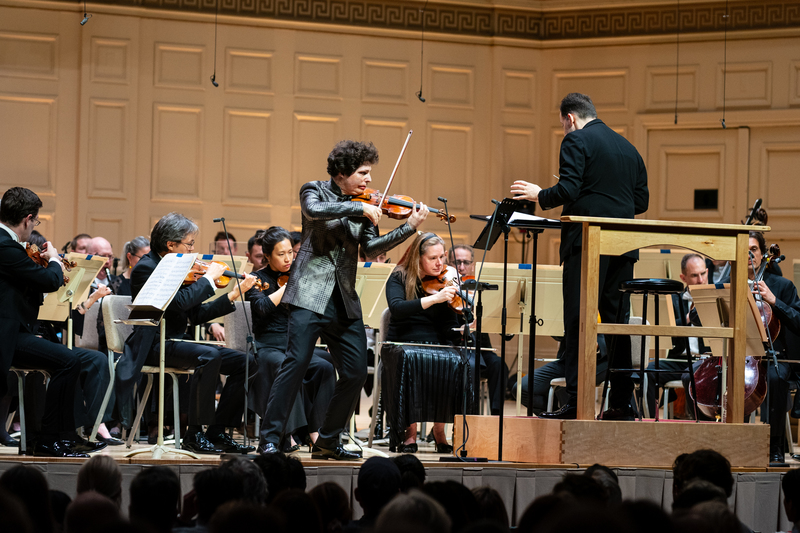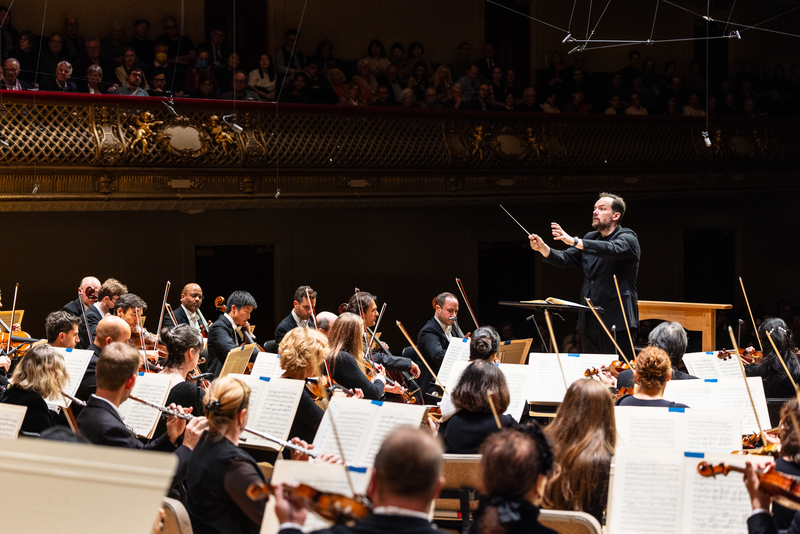Augustin Hadelich and the BSO deliver a convincing performance of Adams, but falter in Tchaikovsky’s Fifth Symphony
Hadelich performs Adams in the first of three collaborations with the BSO this season
Adams’s Violin Concerto, Tchaikovsky’s Symphony No. 5
Boston Symphony Orchestra (BSO)
Conducted by Andris Nelsons
Feat. Violinist Augustin Hadelich
Oct. 16–Oct. 18, 2025
On Friday, Oct. 17, the Boston Symphony Orchestra (BSO) performed John Adams’s Violin Concerto and Tchaikovsky’s Fifth Symphony with violinist Augustin Hadelich as the soloist for the concerto — the first of three upcoming collaborations between Hadelich and the orchestra.
The two works could hardly be more different — yet, intriguingly, both represent their composers grappling with classical form. For Adams, this is his attempt at finally putting melody in a prominent position (if not as prominently as one can, considering the melody appears in moto perpetuo). This Concerto is also his first mature work that can be described as absolute music.
For Tchaikovsky, the symphony had always been difficult, as he excelled in melody but struggled with large-scale forms and the Germanic tradition of motivic development associated with them. While the two composers come from opposite directions, these works both represent their best attempt on the established traditional form of the concerto and the symphony.
Hadelich tackled the concerto with great precision. The first movement is already a challenge in which the “hypermelody” is stated, and the soloist effectively gets no breaks throughout the movement. The movement is effectively a rhapsody, in free form overall but paying homage to the typical concerto’s first movement by including a cadenza. In general, the orchestra was largely at an appropriate volume when accompanying the soloist, and the orchestra took control when they had the more prominent role. Hadelich’s main melodic lines were clearly audible throughout the whole performance as well. “Exotic” instruments such as the synthesizers and extended percussion also gave a nice touch to the piece. Overall, the first movement was intellectually satisfying, but did not have a strong emotional effect. Despite this, Hadelich and the orchestra demonstrated their full potential.
The second and third movements were more straightforward to understand, with their more direct quotations to the Baroque Chaconne and Toccata. The melody of the second movement’s Chaconne was beautiful, and Hadelich played this with grace. Conductor Andris Nelsons also put appropriate emphasis on the ground bass for the second movement, clearly showing that the movement indeed is a Chaconne, with its repeating bass notes and rhythm on the contrabass line. Musically, such repeating structures are Adams’ greatest strengths, stemming from his deep roots in minimalism.
Similarly, the Toccare — while having bluesy elements evident in its rhythm and syncopation —is also a deeply minimalistic piece. Hadelich was still very precise for this difficult movement, but the orchestra was sometimes ever so slightly off on the coordination. In the end, however, the problems were negligible. It is noteworthy to mention that there was more orchestra presence in this movement compared to the first two, but this made sense considering the virtuosic and fast-moving nature of the movement.
The encore was a violin solo arrangement of Carlos Gardel’s Por Una Cabeza; Hadelich conveyed its energetic tango spirit all in just a singular instrument.
After Hadelich performed Adams’s Violin Concerto, he took on Tchaikovsky’s Fifth Symphony, which was the composer’s attempt at a Beethovenian idiom of struggle towards victory. For the first movement of Tchaikovsky, Nelsons conducted at a relaxed tempo. The dynamic changes were on the higher end, at times interrupting the score’s smoother transitions, alongside a stronger brass than what is typical. However, for the energetic first movement, this approach was overall successful. The two themes of the first movement’s sonata form were clearly heard and stated during the exposition, and the ending of the movement in pianississimo was convincing enough that the audience expected the “struggle” to return in the future.
The second movement contains the beautiful horn solo as its main theme, which was executed convincingly to feel the sonority and Tchaikovsky’s mastery of melodic developments. Other solo entrances such as the oboe at the con moto section are almost equally important, and appropriate care was given to them. Nelsons took more liberty in the tempo during this movement, accelerating at the two climaxes of the movement. These drastic tempo changes served the music well, but the orchestra was not always on the same beat, as these accelerations were done quite often in a short period.
In the third movement’s Valse, Nelsons once again puts great emphasis towards the strong triple-meter rhythm of the waltz. The three waltz sections of the scherzo were well-coordinated, and the orchestra sounded like one, often evoking the imagery of an actual waltz happening in a ballroom. The trio section, however, had more coordination issues in the orchestra, especially between the violins and the violas. While this is a flaw, one must note that this is extremely difficult to execute musically — the hemiola is still there, but since the theme is in sixteenth notes, even a slight imprecision carries the risk of accentuating the loss of balance.
The finale is already a problematic movement due to its awkward role in the overarching victory-through-strife story arc and its relative crudeness; Nelsons’ interpretative choices did not succeed in delivering the movement. Interestingly, the section before the final presto was drastically slowed down, alongside other sections which featured extreme rubato going into other quick sections. This broke the momentum going toward the actual climax of the piece as the main theme returned. The orchestra also resorted back to its old habit of playing with a generally faster tempo and letting it run at more exciting moments. The brass was also imprecise and very loud throughout the movement, sometimes even obstructing the perfect cadences of the musical phrases from the strings and woodwinds.
Overall, the symphony was a mixed performance, with a relatively strong first three movements and a more controversial interpretation of the finale. While the structural problems of the symphony have long been a source of debate — especially the forcedness of the finale — the delivery of the finale could have been more consistent. However, the normal strengths of Tchaikovsky in his melodies and lyricism were represented well.






